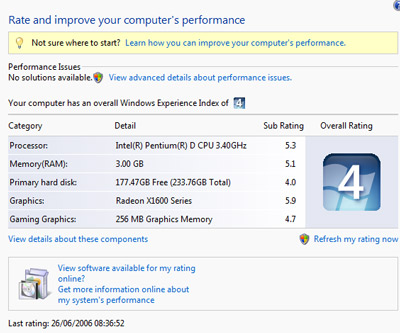The Windows Experience Index and your PC

A few weeks ago I blogged about how Vista's Windows Experience Index was fatally flawed. I'm pleased to say that under the latest Vista build (pre-RC1, build 5536) things are a lot better. In this post I'm going to take a detailed look at the Windows Experience Index and see how it is used to judge the performance of your PC.
It was at the beginning of July that I last took a look at the Windows Experience Index score for my main Vista box back when Windows Vista was at the Beta 2, Build 5456 stage. Back then I was disappointed by the Windows Experience Index system, partly by the fact that the scheme seemed vague, but also because over the course of a couple of weeks, the performance rating for my PC dropped from a healthy 4 to a mediocre 3 when nothing had changed from a hardware point of view. Here's how it changed:

But here's the score it got today:
Things have changed quite a bit in build 5536.
As you can see, the the categories under examination have stayed the same, but Microsoft has clarified what is being tested and judged:
- Processor: Calculations per second
- Memory (RAM): Memory operations per second
- Graphics: Desktop performance for Aero
- Gaming graphics: 3D business and gaming graphics performance
- Primary hard drive: Disk data transfer rate
Overall, these criteria make a lot more sense. These are parameters that are usually fixed and only change when the system is upgraded (although I guess a change in disk data transfer rates could indicate a configurational issue).
Also improved is the base score. Gone is the use of an integer as a base score for the PC, instead this has been replaced with the lowest subscore. This means that your overall PC will be judged by the weakest. While on the surface this might seem unfair, it's actually quite sensible because your PC is being judged by the weakest link in the chain. This tells you what area you need to improve in order to get better performance.
To give you an idea of how your PC will be judged, here's the spec of my Vista box:
- CPU: Intel Pentium D 950, overclocked to 4.1GHz
- RAM: 4GB PC2-5400 667MHz Dual Channel
- Hard drives: 3 x Maxtor DiamondMax 10 SATAII 250GB 16Mb cache
- Graphics card: ATI Raedon X1600 PRO 256MB DDR2
Here are the subscores my system received for each of the criteria tested:
- Processor: 5.1
- Memory (RAM): 4.7
- Graphics: 4.4
- Gaming graphics: 4.7
- Primary hard drive: 5.5
This gives the system a base score of 4.4.
I still think that the base score is a bit of a bogus metric simply because it can be swayed by any one of the criteria. There's no way that you could, for example, buy a game for your PC based on the base score because factors that didn't affect the performance of the game could be lowering the base score. Same goes for most other kinds of software, because rarely does a software applications demand the same levels of performance from all aspects of the PC.
However, I think that the subscores useful because it offers an "at a glance" way to for owners to see how best to spend their upgrade budget. There is even a convenient "print this page" screen where users can get a good overview of their computer (beating, hands down, anything that Windows XP has):
We might even see this system used by PC manufacturers to rate their PCs - it's far better than anything they currently use, although, it is possible to "manually" tweak this rating, so you shouldn't believe everything your see:
There's another way that the Windows Experience Index can give you an insight into your PC - go take a look at the XML file generated (default location is C:\Windows\Performance\WinSAT\DataStore\). Dump this into Internet Explorer and you can see the results of the benchmarks used:
Good work Microsoft!